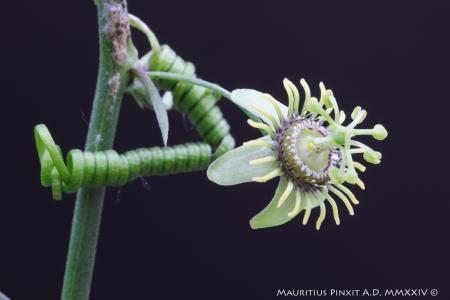
SUBGENUS: de
SUPERSECTION: cieca
GEOGRAPHICAL DISTRIBUTION OR ORIGIN:
Ecuador (Galapagos Islands)
MINIMUM TEMPERATURE: 5 °C
IDEAL MINIMUM TEMPERATURE: 8 °C
ETYMOLOGY: From the Greek τρέις, tréis, three and from δάκτυλος, dáctylos, finger: with three fingers, due to the shape of the leaves formed by three lobes.
DESCRIPTION:
P. tridactylites was considered a variety of P. suberosa, and Ellsworth Killip himself, in his work 'The American Species of Passifloraceae' (1938), considered this name a simple synonym of P. suberosa itself. However, this humble little plant, despite having many similarities, has its own characteristics.
It almost never has trilobate leaves as the name might suggest: they are instead whole, substantial and leathery, elliptical in shape with a sharp apex. Their dimensions are considerable compared to those of the climber: 9 cm in length and 4 cm in width. They are a beautiful dark green with a thick, light ash-green band running along the main rib. The bottom surface is light green. The thin stems are covered with white suberose bark, sometimes with shiny green streaks. The decorative effect is thus assured.
The flowers are green miniatures with the typical morphology of passionflower flowers but without petals. They look like small five-pointed stars decorated with a fine corona made up of two series of yellow-green filaments with a mauve base.
The spherical and pea-sized fruits are black when ripe.
This graceful plant is easy to grow in pots, and one can enhance its aesthetic qualities if one grows it against a light backing made of small canes. The minimum tolerated winter temperature is probably close to 5°C. Its acclimatisation can be attempted outdoors in the citrus-growing areas as well as in protected, sheltered sites in olive-growing areas.
Propagation
from binodal cuttings is simple and the results obtained from seed are equally
good.